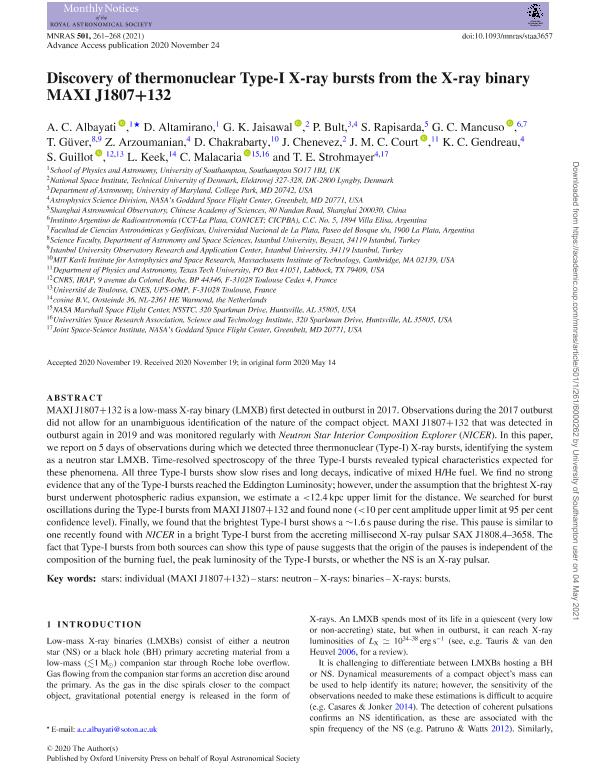Artículo
Discovery of thermonuclear Type-I X-ray bursts from the X-ray binary MAXI J1807+132
Albayati, A. C.; Altamirano, D.; Jaisawal, G. K.; Bult, P.; Rapisarda, S.; Mancuso, Giulio Cesare ; Güver, T.; Arzoumanian, Z.; Chakrabarty, D.; Chenevez, J.; Court, J. M. C.; Gendreau, K. C.; Guillot, S.; Keek, L.; Malacaria, C.; Strohmayer, T. E.
; Güver, T.; Arzoumanian, Z.; Chakrabarty, D.; Chenevez, J.; Court, J. M. C.; Gendreau, K. C.; Guillot, S.; Keek, L.; Malacaria, C.; Strohmayer, T. E.
 ; Güver, T.; Arzoumanian, Z.; Chakrabarty, D.; Chenevez, J.; Court, J. M. C.; Gendreau, K. C.; Guillot, S.; Keek, L.; Malacaria, C.; Strohmayer, T. E.
; Güver, T.; Arzoumanian, Z.; Chakrabarty, D.; Chenevez, J.; Court, J. M. C.; Gendreau, K. C.; Guillot, S.; Keek, L.; Malacaria, C.; Strohmayer, T. E.
Fecha de publicación:
02/2021
Editorial:
Wiley Blackwell Publishing, Inc
Revista:
Monthly Notices of the Royal Astronomical Society
ISSN:
0035-8711
Idioma:
Inglés
Tipo de recurso:
Artículo publicado
Clasificación temática:
Resumen
MAXI J1807+132 is a low-mass X-ray binary (LMXB) first detected in outburst in 2017. Observations during the 2017 outburst did not allow for an unambiguous identification of the nature of the compact object. MAXI J1807+132 that was detected in outburst again in 2019 and was monitored regularly with Neutron Star Interior Composition Explorer(NICER). In this paper, we report on 5 days of observations during which we detected three thermonuclear (Type-I) X-ray bursts, identifying the system as a neutron star LMXB. Time-resolved spectroscopy of the three Type-I bursts revealed typical characteristics expected for these phenomena. All three Type-I bursts show slow rises and long decays, indicative of mixed H/He fuel. We find no strong evidence that any of the Type-I bursts reached the Eddington Luminosity; however, under the assumption that the brightest X-ray burst underwent photospheric radius expansion, we estimate a <12.4 kpc upper limit for the distance. We searched for burst oscillations during the Type-I bursts from MAXI J1807+132 and found none (<10 per cent amplitude upper limit at 95 per cent confidence level). Finally, we found that the brightest Type-I burst shows a ∼1.6 s pause during the rise. This pause is similar to one recently found with NICER in a bright Type-I burst from the accreting millisecond X-ray pulsar SAX J1808.4-3658. The fact that Type-I bursts from both sources can show this type of pause suggests that the origin of the pauses is independent of the composition of the burning fuel, the peak luminosity of the Type-I bursts, or whether the NS is an X-ray pulsar.
Archivos asociados
Licencia
Identificadores
Colecciones
Articulos(IAR)
Articulos de INST.ARG.DE RADIOASTRONOMIA (I)
Articulos de INST.ARG.DE RADIOASTRONOMIA (I)
Citación
Albayati, A. C.; Altamirano, D.; Jaisawal, G. K.; Bult, P.; Rapisarda, S.; et al.; Discovery of thermonuclear Type-I X-ray bursts from the X-ray binary MAXI J1807+132; Wiley Blackwell Publishing, Inc; Monthly Notices of the Royal Astronomical Society; 501; 1; 2-2021; 261-268
Compartir
Altmétricas



